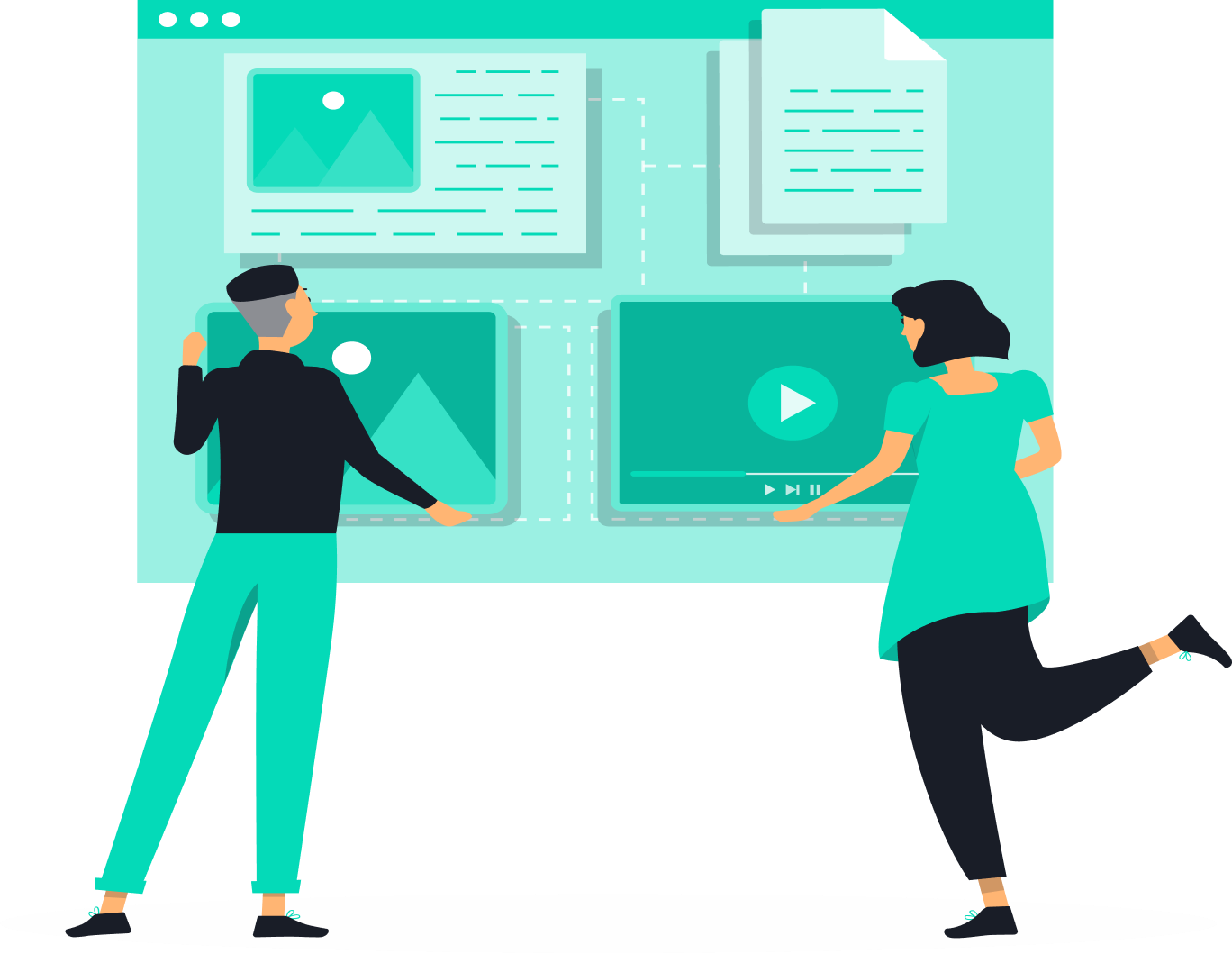
Home > Building a Content Marketing Strategy For SaaS Company
Table of Contents
Toggle
Over 4 million blog posts are published on the Internet every day, but how many are actually effective or even worth reading?
Well, that’s something content marketing strategy helps you with.
Content Marketing is a vital part of every SaaS brand. Quickly scanning the websites of SaaS companies will be enough proof for our statement. Almost on every SaaS website, you will find either a “Resources” or “Learn” section with varying content like blogs, webinars, ebooks, research and reports, and guides. In short, everything a customer might be looking for.
SaaS Content marketing costs around 62% less than outbound marketing and generate 7.8x more traffic and 4x more leads per $1000.
For me, content marketing is creating resources that people can read, hear, see, and promoting them in order to generate traffic, leads, sales, and referrals.
It’s bestowed with the power of converting visitors to paid customers by pushing them down the buyer’s funnel.
But what if visitors aren’t excited by your content? What if it’s not engaging?
Scary, right? Because content creation takes a lot of effort, time, brainstorming sessions and if the results aren’t satisfactory, all this will be a waste.
All you need is, to do content marketing the right way so that it maximizes your ROI and improves your brand’s reach.
If you’re not using the content or if the content you already have hasn’t been fruitful for your business, it’s not strange that your belief in this power tool has been shaken. You might be wondering if it’s even worth the investment.
The answer is “Yes”. (I might be a little biased here, being a content writer myself!)
You might have developed a great product with some awesome features and functionalities, but it won’t matter if your users don’t understand your product or don’t see the point of getting it.
So, content marketing provides you an opportunity to help them understand your product, its features, and usability, and convinces them to eventually buy.
Your content plays a very important part in conveying how your product works, and how it can solve the problems your customers are facing. Educating your customers is a critical part of the SaaS strategy, which makes content the most important tool at your disposal to market your SaaS product.
We’ve come up with 7 steps with which you can come up with your effective SaaS Content Marketing Strategy
While buyer personas can be helpful, you should never forget that you’re writing for a living, breathing person. So we suggest instead of sticking to fictitious personas, for a SaaS startup, you should focus on your potential customer’s intent.
Like John Romero, the Game Development icon said, “In marketing, I’ve seen only one strategy that can’t miss – and that is to market to your best customers first, your best prospects second and the rest of the world last.”
When developing a content marketing strategy, the thing you need to ask yourself is who are your best customers?
What are they looking for?
What questions they might have in mind?
What problems they might be facing?
What topics will help them with their tasks?
If you’re able to answer these questions related to your customers, you’re all set to build an effective SaaS content strategy.
When developing content, our main focus is always on customer intent. Whether it’s a casual visitor, a lead, or your existing customer, you need to satisfy all of them with prompt information.
For a SaaS company, it’s vital that you create content for each stage of the buyer’s journey. So the first thing to do here will be to funnel your buyer’s behavior. We’ve narrowed it down to 5 stages:
Think of this process as climbing stairs. At first, you need to create a general awareness of your product or service.
At this stage, you can use long-tail keywords in articles, engaging infographics, and images to attract attention. You have an open field. Do whatever it takes to spread awareness.
Once you’ve created awareness, your next step will be engaging your audience and earning their trust. Here you can again use high-value and informative content and images, but the most useful weapon you’ve are the testimonials.
After the first 2 stages, your customers should now be willing to sign up or subscribe for a free service like a newsletter or even better a product trial or maybe walk them through a demo session of your product
Give your customers enough time to figure out the benefits of your product. Now that they’ve tried your product, convince them to switch to the paid version. This can be made possible by exposing them to the additional valuable features and tools within the software.
Don’t forget your customers once they’ve paid for a service or a product. Keep them posted and continue providing them with valuable features, tools, and above all support.
For example, HubSpot, their content marketing strategy focuses on its blog and premium content offers. They’ve engaging content for each part of the funnel that helps them generate over 1 million page views per month.
Content with visuals gets 94% more total views and is 40x more likely to be shared on social networks. Visuals have longer retention than text, so if you’re creating content, make sure it’s worth remembering and they’re able to clearly understand your product.
SaaS startups are viewing infographics as a better way of sharing their product details. They’re a great way to give customers a walkthrough of your product for which you would’ve to create a 4-5 minute video.
For SaaS Startups, onsite SEO is very important. Not all SEO keywords will generate the same results. To get traffic that converts, search the High Intent, Low Volume keywords, they’ll give you an idea of the most looked-up feature of your product.
Use competitor analysis to learn what keywords are working for them. Use Google’s AutoSuggest for keyword suggestions, Ahrefs, or Moz for competitor analysis, and Keyword Planner for the frequency of your shortlisted keywords.
It’s good to keep your visitors posted whenever you launch a new service or product or add features to your existing product. Remember, this strategy works on existing customers better. Inform them about the new features they haven’t tried yet and encourage them to do so.
Don’t spam their inbox!
Just remind them about the recent upgrades, for example, whenever HOTH, an SEO service company, adds new features to their keyword ninja or ranking checker, they never fail to share it with their existing users and motivate them to stay on board.
Ask your visitors to first try your product by signing up for a free trial. Let them try before they buy. The freemium model is known to work the best for SaaS companies.
If your visitors have used and most importantly liked your product, they might be willing to switch from freemium to the paid version as well. Apart from free trials, offering extensions will amplify the customer’s visits and purchase of your product too.
In addition to this, you can use in-app upgrades – this will help users use the app even during their upgrade and it’s a great way to keep making improvements. However, it’s not necessary to buy those upgrades. Content like Emails, Newsletters, infographics will work wonders whenever you get a new feature for your product.
Learning and Improvising are crucial to retaining prospective cancellers.
Get feedback from your customers, especially the ones who are canceling their subscriptions. With predictive analysis (tools like ProfitWell, ChartMogul, Insight can help here), you can understand which customer is most likely to cancel the subscription.
This will help you understand which features of your product work the best and which don’t, so you can work on the loopholes and provide them with better solutions and services in the future. Curate content for Emails, Blogs, and Newsletters accordingly to answer their queries.
Planning and developing a robust content marketing strategy and a smart execution, using the proper tools and tactics, and keeping an eye on the analytics can help SaaS companies reach out to target customers and shoot up their sales.
Rajashree is the Lead Content Writer at FirstPrinciples Growth Advisory, specializing in SaaS product marketing content. With 8+ years of experience as a writer turned researcher, she has a deep-rooted affinity for B2B SaaS content writing & strategy planning. She excels in transforming complex solutions into engaging articles that address...